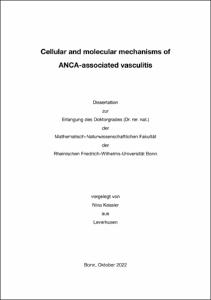Cellular and molecular mechanisms of ANCA-associated vasculitis

Cellular and molecular mechanisms of ANCA-associated vasculitis

| dc.contributor.advisor | Garcia Garbi, Natalio | |
| dc.contributor.author | Kessler, Nina | |
| dc.date.accessioned | 2023-07-12T15:34:00Z | |
| dc.date.available | 2024-07-15T22:00:19Z | |
| dc.date.issued | 12.07.2023 | |
| dc.identifier.uri | https://hdl.handle.net/20.500.11811/10938 | |
| dc.description.abstract | ANCA-associated vasculitides (AAV) are a group of life-threatening autoimmune diseases that lead to necrotizing inflammation of the small and medium-sized blood vessels in various organs. Pulmonary hemorrhages are associated with the worst prognosis. It is believed that degranulation of neutrophils, the subsequent release of DNA, and the resulting formation of immune complexes with anti-MPO or anti-PR3 antibodies are critical mediators of disease pathogenesis. However, AAV’s cellular and molecular mechanisms remain little understood partly because of a lack of robust animal models. We established a novel and reproducible mouse model for anti-MPO-induced pulmonary vasculitis that results in severe lung pathology and hemorrhages that resemble disease in patients.
Using this model, we found that signaling via the stimulator of interferon genes (STING) and the interferon receptor (IFNAR-1) promoted pulmonary AAV. We identified infiltrating macrophages as high producers of pathogenic IFN-ß in the bronchoalveolar space using luciferase reporter mice. Consistently, depletion of those macrophages ameliorated disease, indicating a pro-inflammatory role in disease development. In contrast, alveolar macrophages contributed to dampening inflammation and clearing lung hemorrhages by phagocytosing extravascular red blood cells. 64% of patients with MPO-AAV are women. In line with this, we observed a higher variability in disease severity in female mice. Further analysis revealed that estradiol supplementation, in contrast to progesterone, lowered pulmonary hemorrhages and dampened immune cell infiltration. Further studies are required to elucidate the exact anti-inflammatory mechanism of estradiol in ANCA-associated vasculitis. This study, thus, identifies the STING/IFN-I pathway to promote severe lung hemorrhages during AAV and provides potential targets for pharmacological intervention. Furthermore, we have unveiled a dual role of macrophages in this disease. Whereas infiltrating macrophages promote disease severity by producing pathogenic IFN-β, resident alveolar macrophages stimulate disease resolution by clearing extravascular red blood cells (RBCs). Moreover, we provide evidence that estradiol supplementation mediates anti-inflammatory signaling and ameliorates AAPV progression. | en |
| dc.language.iso | eng | |
| dc.rights | In Copyright | |
| dc.rights.uri | http://rightsstatements.org/vocab/InC/1.0/ | |
| dc.subject | ANCA-associated vasculitis | |
| dc.subject | lung | |
| dc.subject | hemorrhages | |
| dc.subject | STING | |
| dc.subject | IFNAR | |
| dc.subject.ddc | 500 Naturwissenschaften | |
| dc.subject.ddc | 570 Biowissenschaften, Biologie | |
| dc.title | Cellular and molecular mechanisms of ANCA-associated vasculitis | |
| dc.type | Dissertation oder Habilitation | |
| dc.publisher.name | Universitäts- und Landesbibliothek Bonn | |
| dc.publisher.location | Bonn | |
| dc.rights.accessRights | openAccess | |
| dc.identifier.urn | https://nbn-resolving.org/urn:nbn:de:hbz:5-71400 | |
| dc.relation.doi | https://doi.org/10.1084/jem.20220759 | |
| ulbbn.pubtype | Erstveröffentlichung | |
| ulbbnediss.affiliation.name | Rheinische Friedrich-Wilhelms-Universität Bonn | |
| ulbbnediss.affiliation.location | Bonn | |
| ulbbnediss.thesis.level | Dissertation | |
| ulbbnediss.dissID | 7140 | |
| ulbbnediss.date.accepted | 22.06.2023 | |
| ulbbnediss.institute | Medizinische Fakultät / Institute : Institut für Experimentelle Immunologie (IEI) | |
| ulbbnediss.fakultaet | Mathematisch-Naturwissenschaftliche Fakultät | |
| dc.contributor.coReferee | Förster, Irmgard | |
| ulbbnediss.contributor.orcid | https://orcid.org/0000-0002-4935-5051 | |
| ulbbnediss.date.embargoEndDate | 15.07.2024 |
Dateien zu dieser Ressource
Das Dokument erscheint in:
-
E-Dissertationen (4446)




